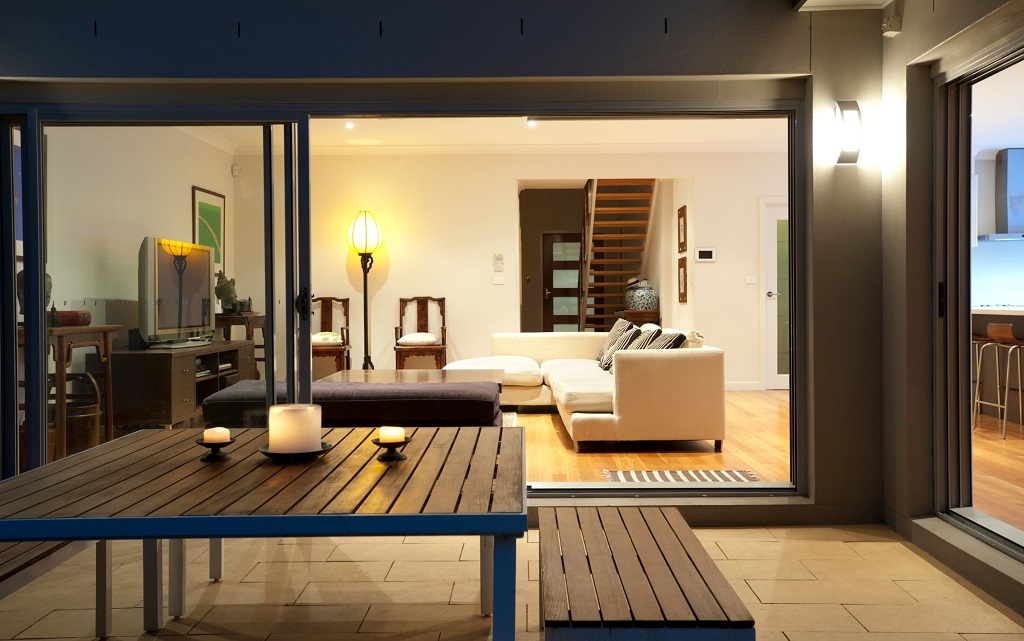From traditional rural homes with white picket fences to modern luxury condominiums in towering urban skyscrapers, the dream of homeownership has meant many things, while long holding a special place in the hearts of many Americans. As the Millennial Generation matures, the real estate sector is going through massive changes largely due to this unique generation’s distinct wants, goals and lifestyle preferences.
In particular, the practice of listing and accurately pricing your home now must consider Millennials as another important variable in the equation. Homesellers need to understand how Millennials are pervasively impacting the US real estate market with their distinctive beliefs, interests, and technological aptitude.
This article explores how the real estate market is adapting to meet the needs of the Millennial Generation, while simultaneously redefining what it means to own a home in the United States. Most importantly, these tips will also help homeowners, real estate professionals, and investors understand how to make a property discoverable and desirable in the eyes of millennial homebuyers!
Table of Contents
- Why You Need to Understand Millennials When Selling Your Home
- 5 Unique Traits & Interests of Millennial Homebuyers
- The Millennials’ Impact on the Real Estate Market
Also see:
Why You Need to Understand Millennials When Selling Your Home
Since its formation, the real estate industry has inherently needed to be versatile, adjusting to prevalent requirements of emerging generations and their changing lifestyles over many decades. The tradition of versatility continues in today’s market as real estate professionals of all stripes grapple with changing preferences due to the Millennial Generation’s rise.
As the largest demographic group in the workforce today and a growing buying force in the real estate market, Millennials, those persons born within the years of 1981 and 1996, are making their presence known. With ages ranging from 27 to 42 at the time of this article being published, their distinct pursuits, mindsets, and lifestyles are changing how homes are sold and how real estate agents operate, as this iconic generation reaches the peak homebuying age. A recent Zillow study found that the largest cohort of homebuyers (26%) is within the ages 30 and 39 and that Millennials represented 36% of all homebuyers.

Findings published in 2022 from a research panel managed by Kantar further revealed how convenience and time savings are significantly more important to millennial homeowners than non-millennial homeowners. An inference can be drawn that this generation’s penchant for online shopping and research is directly related to convenience and efficiency. Specifically, 74% of millennial homeowners have maintained a high preference for online shopping in recent years (versus only 47% of non-millennial homeowners). Markedly consistent with their online shopping behavior, 75% of millennial homeowners responded that saving time was very important to them (versus only 46% of non-millennial homeowners).
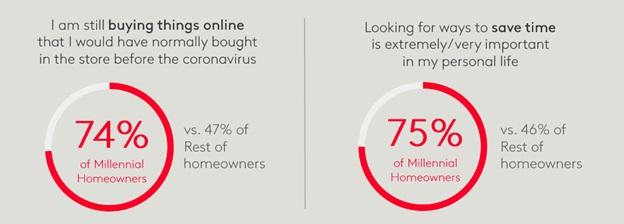
Image courtesy of Kantar
No matter when you may plan to sell your home, now is a perfect time to increase your understanding on how your home may be discovered and perceived by this large and influential base of potential homebuyers.
Also see:
5 Unique Traits & Interests of Millennial Homebuyers
Here are several distinct traits and interests of millennial homebuyers that all homesellers and real estate professionals need to comprehend thoroughly prior to selling a property:
- Different Homeowner Priorities
- Tech-Empowered Lifestyles
- Eco-Wellness Lifestyles
- Cohabitation Spaces
- Personalized Homes
1. Different Homeowner Priorities
Millennials are prioritizing homeownership differently than earlier generations. The millennial demographic group is generally more interested in urban living and being close to amenities than previous generations, who preferred large suburban homes with spacious lawns.
Millennials are also placing a high importance on:
- Community Vitality
- Accessibility to Public Transportation, and
- Walkability
In response, real estate developers and builders have been concentrating on urban growth, building mixed-use neighborhoods with a blend of residential, commercial, and recreational zones.

Additionally, the market has been forced to provide a wider range of housing options due to the rise in demand for smaller, more inexpensive housing options like micro-apartments, townhouses, and detached zero-lot-line single-family condominium homes.
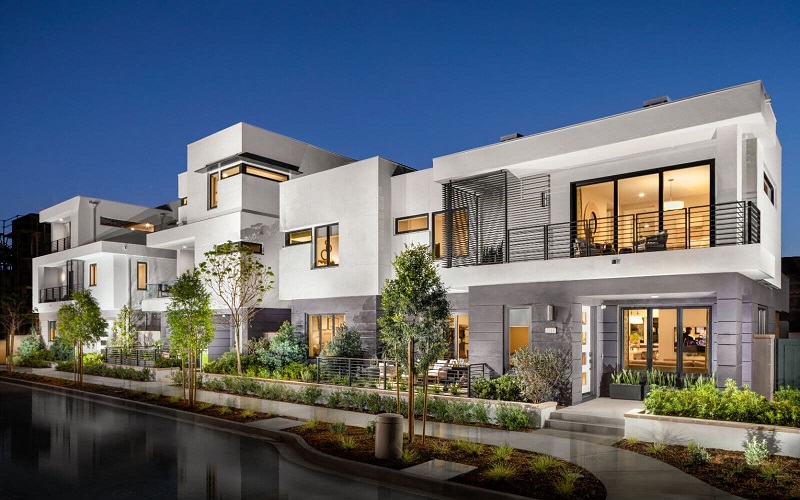
Single-family zero-lot-line Cira models at The Landing at Tustin Legacy, a master-planned community developed by Brookfield Residential
In recent years, numerous businesses have shared plans to transition to a “hybrid” workstyle, in which they allow staff to work from home on specific days each week. This trend was detected early by Gensler’s 2020 Global Workplace Survey, in which 52% of US respondents said they were looking forward to a hybrid work paradigm that would allow them to split their working hours between their homes and offices as needed. Another 19% of US respondents stated that they would prefer to work remotely full-time.
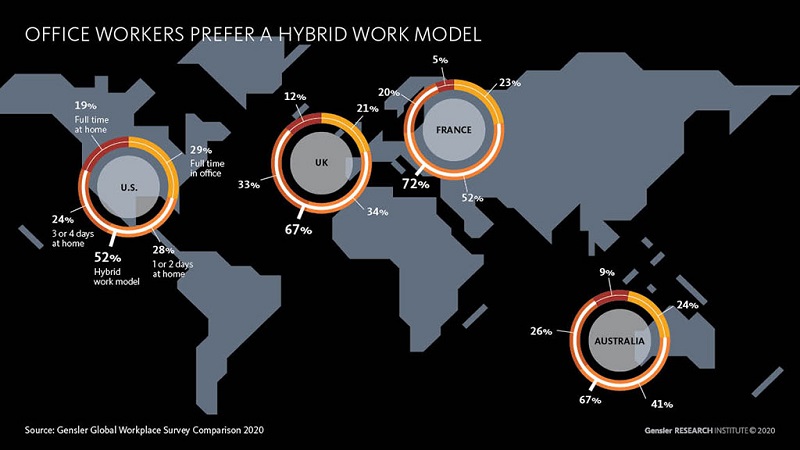
Image courtesy of Gensler
Now, according to Zippia, 74% of U.S. companies are using or plan to implement a permanent hybrid work model.
With the rise of remote working, homes wishing to be competitive must address how their respective layouts can accommodate a home office. Even if a dedicated home work space is implausible, demonstrating how spaces can be easily “transformed” to handle occasional work-from-home situations would be valuable.
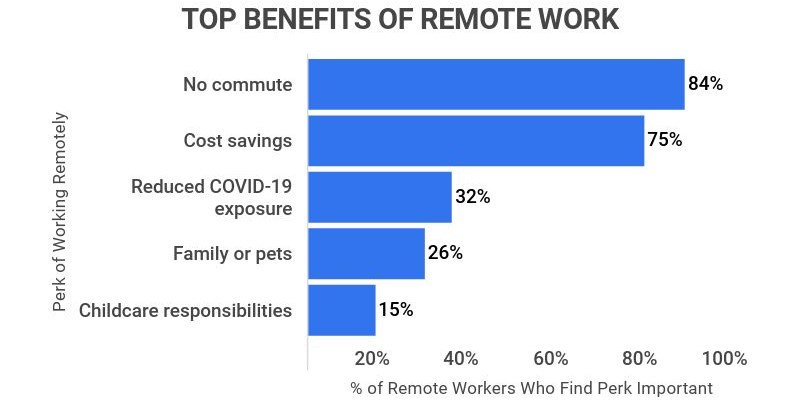
Image courtesy of Zippia
Additionally, the growing population of remote workers also represent opportunity for developing mid-sized cities to recruit millennial residents by establishing more affordable communities of interest to Millennials.
Given the high levels of uncertainty in recent years, promoting how your property has “built-in flexibility” (e.g. pre-approved building plans; larger-than-average lot; transformable spaces; ADU-friendly incentives; no HOA or deed restrictions; etc.) would also be valuable to highlight to prospective millennial buyers.
Also see:
2. Tech-Empowered Lifestyles
Recent National Association of REALTORS® (NAR) research has found that 99% of homebuyers between the ages of 23 and 56 utilize the Internet to identify properties during the homebuying process. In order to shop for homes conveniently without leaving the comfort of their homes, homebuyers have also been relying on virtual tours as an effective way to discover “short-list” properties.
An Example Guided 360 Virtual Real Estate Video Tour by Real Estate Marketing on Social Media
When homesellers prepare their homes to be listed, it would be a wise exercise to imagine how modern shoppers use the Internet and social media to research and make purchase decisions, big and small. Though the percentage of remote homebuyers is increasing, homesellers should still focus on using their online listings to persuade in-person visits.
Understanding the unique strengths of your home and neighborhood, and who will most value these traits is a critical first step in marketing your home. This process also needs to include describing your home using “keywords” of top significance that are used by millennial homebuyers (e.g. walkability; nearby amenities; turnkey; sustainability; energy-efficiency; pet-friendliness; low-maintenance; co-living amenities; short-term rental-friendliness; etc.).
Astute home shoppers have been using online research to find well-targeted prospective homes efficiently while forgoing unnecessary, time-consuming treks to homes that would be “categorically non-fits”. Old-school methods of visiting too many homes in person could lead to “home shopping fatigue” and settling for a less-than-ideal property.
Virtual tours are now possible, thanks to advancements in technology, giving potential buyers the chance to thoroughly examine a house online and from afar. The process of buying a property is now much more flexible and efficient than ever before thanks to the removal of several traditional constraints. Though high-quality videos and photos are critical to showcase your home effectively online, floor plans are also highly effective visual elements that can also help prospective buyers emotionally connect with your property.
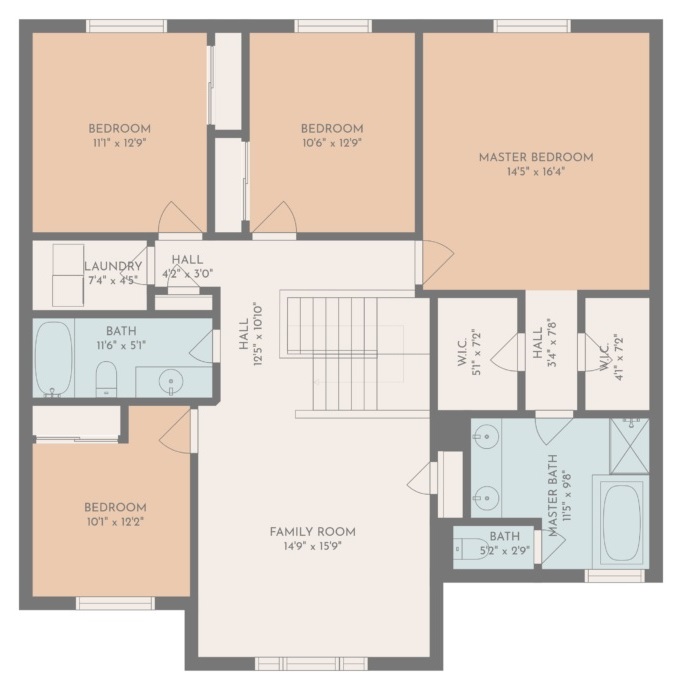
Image courtesy of CubiCasa
Also keep in mind the importance of relevant “data”, “text” and “search filters” that prospects will be relying on in order to discover your property!
In a similar vein, modern technology is influencing how real estate agents interact with their clients. Another recent NAR survey found that 86% of property purchasers still deemed real estate agents to be a very or somewhat useful information source.
Another great example of convenient interactive technology is one-on-one livestream virtual tours. With this type of tour, a prospective buyer can have an agent virtually walk them through the house, using a streaming video camera and microphone, discussing the house and neighborhood, as if they were together in-person.
Buyers and sellers can also connect with real estate experts more conveniently and efficiently, including discussing buying specifications and closing transactions with ease, thanks to the introduction of other new communication channels such as video conferencing and meetings, social networking, text messages, and messaging apps.
Also see:
3. Eco-Wellness Lifestyles
Millennial homebuyers’ desire for “green spaces” and “wellness features”, such as natural lighting and non-toxic materials, results from an intentional goal to live healthy and environmentally-responsible lifestyles. To stay relevant to this growing homebuyer sentiment, realtors have incorporated “green” and wellness living into their project designs and construction methods.
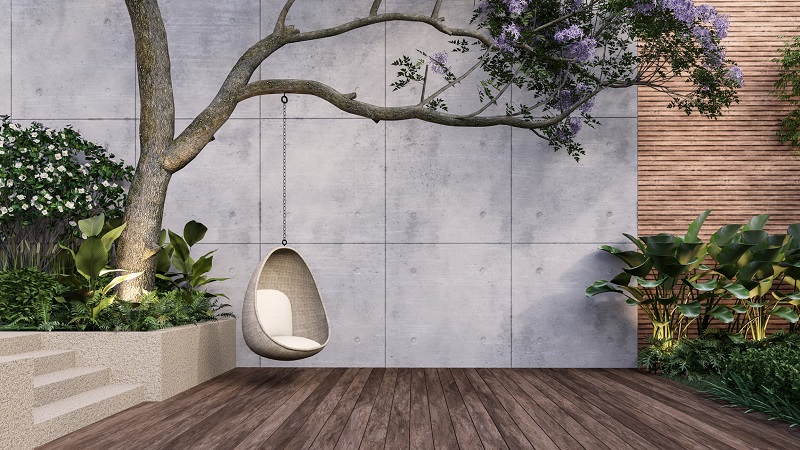
Additionally, real estate developers are striving to realize the all-encompassing advantages that these communities provide. Only if sustainable features are planned and integrated at the onset of a project, and only if the project design is made to inspire clients with attention to detail, can a “green community” achieve its purpose.
Sustainable housing is aiming to establish accommodating areas where occupants have the opportunity and desire to stay longer, even through major life stages, such as households with growing families and seniors adjusting to aging in place. In parallel, these communities are striving to adapt responsibly to socioeconomic development over time, by being considerate and respectful of the surrounding natural settings.
Also see:
4. Cohabitation Spaces
A greater proportion of young adults are relocating to or remaining in big cities as a result of economic and social circumstances. This trend runs counter to the traditional 20th-century path of settling down and moving to a larger home in the suburbs, which has had a major impact on the development of residential communities. In parallel, the need for new and enhanced senior-living communities is growing as older generations are living longer and healthier lives.
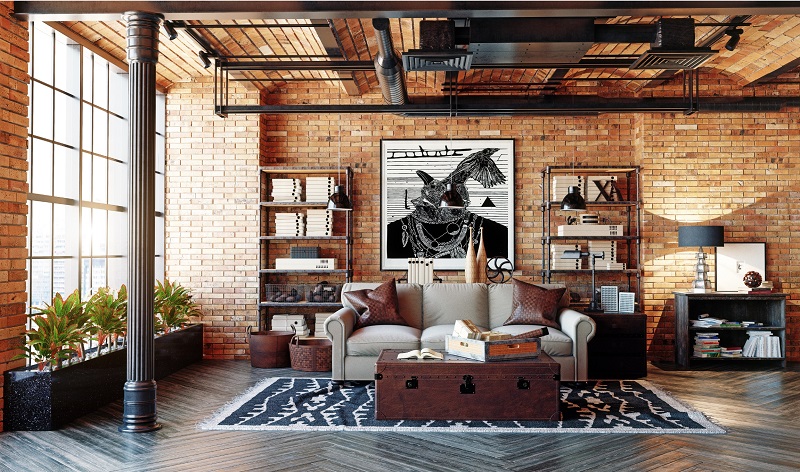
Co-living housing brings young individuals opportunities to reduce the cost of city living without giving up modern conveniences, such as outdoor spaces, gourmet kitchens, full-sized laundry appliances, or fitness amenities. In a time when feelings of isolation and being separated have been at an all-time high, co-living arrangements can provide “instant, built-in community”, with shared gathering and activity spaces that promote daily social interaction.
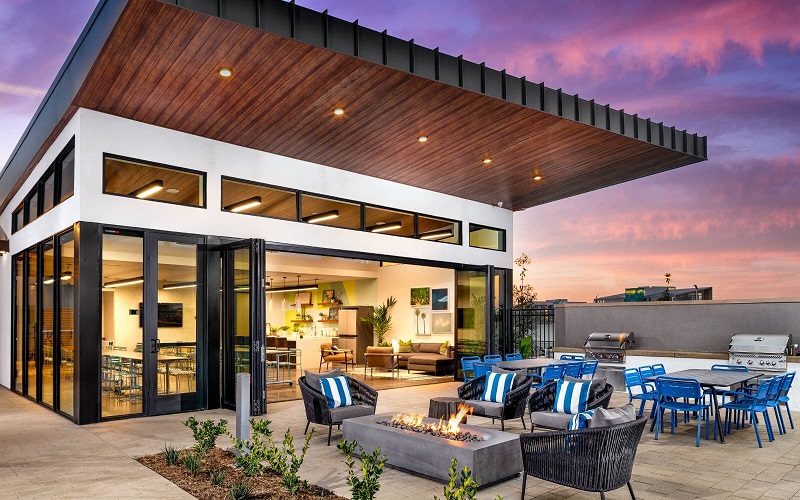
The community clubhouse at the Landing at Tustin Legacy developed by Brookfield Residential
When co-living turns into a homeownership partnership, in legal terms this is referred to as “joint tenancy”. In current vernacular, this type of “co-homeownership” is being commonly called “co-buying”.
Co-living is also becoming a popular option for senior citizens who want to avoid the upkeep and responsibility of a single-family home, but who can’t afford or don’t yet require the care of a regular nursing home. When the trends of cohabitation, aging in place, “boomerang kids”, and ADUs become intertwined, this leads to another growing cohabitation trend of “multigenerational living”.
Also see:
5. Personalized Homes
The modification and personalization of virtually everything in the lives of millennials, including their homes, is an important and expected feature. Millennials want choices and “settings” that accentuate their uniqueness and that promote self-expression.
As a result, the real estate industry has been motivated to provide additional options for customization during the homebuying process.
To satisfy millennials’ craving for modification and personalized control, developers have been introducing:
- Flexible Floor Plans
- Modular Designs
- Adjustable Finishes, and
- Digital Twins
On the “personalized design front”, The Landing at Tustin Legacy by Brookfield Residential, a new master-planned community in Orange County, California, is a great example of delivering “individual taste and lifestyle” through design. Their Design Studio service incorporates a style survey, options wish list, and lookbook which all lead to a one-on-one tailored meeting with a professional designer to finalize choices.
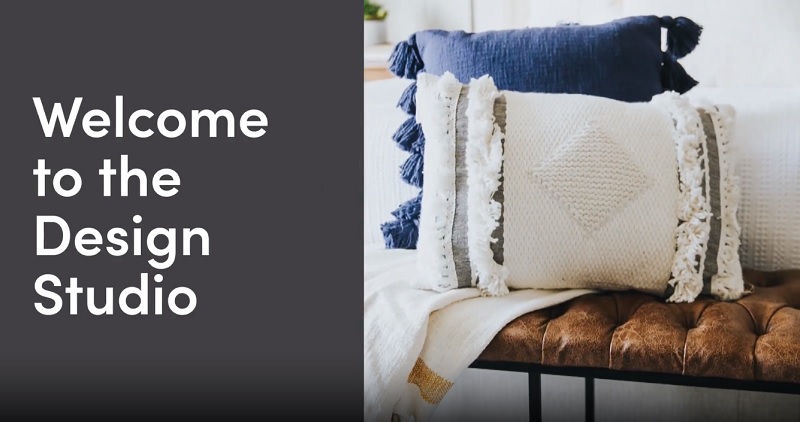
For existing homes, virtual staging is another effective way to showcase how your property can fit the lifestyles of a wide-range of prospective buyers. For example, one set of virtually staged images could present the home as it could be experienced by a young family (e.g. baby’s room; child furniture and décor; child-friendly features; outdoor play areas; etc.). Another scenario could cater to older empty-nesters with rooms emphasizing their interests and hobbies (e.g. fitness; home office; guest bedrooms; entertaining amenities; low-maintenance yards; etc.).
Regarding the need for “personalized control”, residential digital twins are an ideal offering for tech-empowered Millennials. Though the concept of an interactive model and dashboard to manage one’s home is still nascent, Millennials will likely prove to be early adopters and valuable first-generation users of this highly promising technology. For example, the digital twin startup Digs announced in May 2023 that their first group of new homebuilders began handing over “digital binders” (AKA first-generation digital twins) to new homeowners which were received with positive excitement.
Additionally, the sector is investigating more advanced technologies like Augmented Reality (AR) and Virtual Reality (VR) to allow a purchaser to see and personalize their houses even further before making a purchase.
Also see:
The Millennials’ Impact on the Real Estate Market
Millennials are attached to their gadgets, and not surprisingly, technology is essential to their homebuying process. Millennials use the Internet to research the housing market in general, prospective neighborhoods to narrow their search, and then individual home listings in greatest detail.
According to a Zillow analysis from 2021, a majority of millennials (59%) said they would feel “at least somewhat secure” placing an offer on a home they virtually toured, while 39% said they would feel “at ease” making an online real estate purchase. The study additionally found that more than 80% of millennials would want to examine 3D virtual tours and digital floor plans when looking for a home.
Enterprising startups, such as CubiCasa, are offering solutions that are empowering real estate professionals and homeowners to provide what prospective homebuyers need to make confident and informed purchase decisions.
An Easy Way to Create Floor Plans Using the CubiCasa App
According to NAR research, 90% of agents communicate by text, and 94% do so via email, indicating that they are adjusting to this demand for electronic written communication. Another 34% engage in instant messaging conversations with customers.
The generation most likely to care about living close to their location of work is the Millennials, according to a survey. Of those surveyed, 44% rated commuting costs as very important when choosing a place to live, 74% rated neighborhood convenience in terms of their job as important, and 58% rated overall affordability as important.
In short, Millennials are game changers. The real estate industry has been significantly impacted by Millennials, and as the next generation of homebuyers continue to enter the market, further changes could be in store. To put that evolution in perspective, it is important to concentrate on the beneficial advances influenced by Millennials.
In this case, a focus on technology might lead to a simplified, more effective homebuying process. Also, a greater number of millennials relocating to the suburbs might help counteract the effects of rising housing costs in cities. The next time you plan to show your home and list it on the market, it will certainly be in your best interest to consider how it will relate to Millennials.
About the Author
David Tully is a licensed real estate agent at eXp Realty, based in Reno, Nevada. David enjoys applying his passion for technology and social media to provide high-value communication with his clients that incorporates privacy, security, speed and efficiency. He specializes in helping first-time homebuyers, investors, and persons relocating to the Reno/Sparks area.
Recommended Reading
- Not in Love with Your Home? Turn It into an Investment Property!
- What is a Clean Offer in Real Estate?
- What does Opendoor’s Situation Mean for the Future of iBuying?
- What You Should Know When an Agent Represents Both Buyer & Seller
| Purgula is reader-supported. When you click on links to other sites from our website, we may earn affiliate commissions, at no cost to you. If you find our content to be helpful, this is an easy way for you to support our mission. Thanks! Learn more. |

